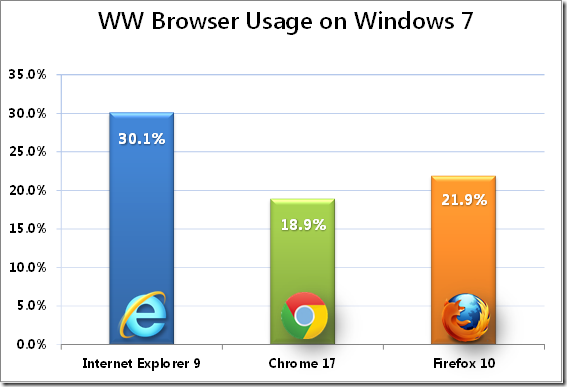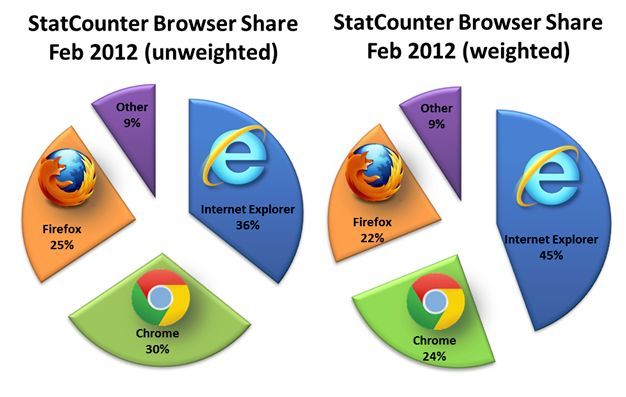Microsoft chooses Net Applications to calculate browser statistics
At the beginning of each month, Microsoft publishes the latest browser popularity statistics in the official Internet Explorer blog . In the same way, they did the first of March, publishing a report with a graph in which IE 9 outperforms Google Chrome and Mozilla Firefox browsers on Windows 7.

Microsoft is based on results taken from Net Applications. However, there is another company, StatCounter, which also offers statistics on the browser market. In a new IE blog post, Roger Capriotti explains the reasons why the company prefers to use information gathering techniques from Net Applications, rather than StatCounter.
The first reason is that StatCounter collects information from Google Chrome even when the browser pre-loads the pages. Chrome users sometimes may not visit those pages that were preloaded. Microsoft is repelled by the fact that since February of this year, Net Applications has removed the pre-loaded Chrome data from the main traffic statistics, saying that “pre-loading in February 2012 was 4.3% of the daily unique visitors using Chrome.”
')
Another reason is that StatCounter simply takes the absolute number of page views to compile its results. Microsoft says that Net Applications also considers geo-weighting as part of its results. This means that they consider the data based on the overall prevalence of the Internet among the population in each country. Net Applications uses information collected by the CIA to obtain data on the use of the Internet in the country.
Net Applications says:
For contrast, StatCounter considers China to be the 22nd country in terms of the number of Internet users, based on the number of page views that people in this country generate. However, these StatCaunter values are obtained only due to the sites it covers, although in fact China has the largest Internet audience in the world.

Microsoft decided to compare StatCounter browser data with the same information, plus adding the weight of the real Internet audience for each country. The results are shown in the graph above, where you can see that Internet Explorer has grown by 9%, while Chrome and Firefox have lost their percentages.
So, you can conclude that at the time when StatCounter uses pageview values for its browser statistics, Net Applications counts unique visitors. Microsoft argues that the simple use of page views can be misleading, since the information received from browsers in this way can lead to incorrect results, since Internet bots can generate more page views.
And a small comment from me, as from a translator:
I was always neutral about Microsoft and rather negative about their browser. At the same time, StatCounter has always preferred to view browser statistics. However, if the statements above are true, then only this picture comes to my mind:

UPD: Eh, comrades, I could not convey the meaning of the article to everyone. The problem is not that the blue browser is ahead of orange or green, now it does not matter.
It is important what methods are used by statistical offices. Most often on Habré graphs from StatCounter flash, but after all, their method of calculating statistics on page views is just nonsense, isn't it?
Those who have their own website and who monitor its attendance can confirm that the number of views is a rather abstract figure, and it is impossible to draw up a complete picture of attendance using it.
And this is at the same time that Net Applications counts unique visitors.
Imagine that a person came to your site with Google Chrome and walked through 10 pages, and then another with Firefox, but stopped only on one page.
As a result, StatCounter will conclude that Chrome is 10 times more popular than FF. Net Applications also says that the popularity of 50/50.
Which is more correct?

Microsoft is based on results taken from Net Applications. However, there is another company, StatCounter, which also offers statistics on the browser market. In a new IE blog post, Roger Capriotti explains the reasons why the company prefers to use information gathering techniques from Net Applications, rather than StatCounter.
The first reason is that StatCounter collects information from Google Chrome even when the browser pre-loads the pages. Chrome users sometimes may not visit those pages that were preloaded. Microsoft is repelled by the fact that since February of this year, Net Applications has removed the pre-loaded Chrome data from the main traffic statistics, saying that “pre-loading in February 2012 was 4.3% of the daily unique visitors using Chrome.”
')
Another reason is that StatCounter simply takes the absolute number of page views to compile its results. Microsoft says that Net Applications also considers geo-weighting as part of its results. This means that they consider the data based on the overall prevalence of the Internet among the population in each country. Net Applications uses information collected by the CIA to obtain data on the use of the Internet in the country.
Net Applications says:
For example, if our global data shows that Brazil accounts for 2% of our traffic, and CIA data shows that Brazil makes up 4% of global Internet traffic, we will count each unique visitor from Brazil twice. This is done in order to balance our global data.
For contrast, StatCounter considers China to be the 22nd country in terms of the number of Internet users, based on the number of page views that people in this country generate. However, these StatCaunter values are obtained only due to the sites it covers, although in fact China has the largest Internet audience in the world.

Microsoft decided to compare StatCounter browser data with the same information, plus adding the weight of the real Internet audience for each country. The results are shown in the graph above, where you can see that Internet Explorer has grown by 9%, while Chrome and Firefox have lost their percentages.
So, you can conclude that at the time when StatCounter uses pageview values for its browser statistics, Net Applications counts unique visitors. Microsoft argues that the simple use of page views can be misleading, since the information received from browsers in this way can lead to incorrect results, since Internet bots can generate more page views.
And a small comment from me, as from a translator:
I was always neutral about Microsoft and rather negative about their browser. At the same time, StatCounter has always preferred to view browser statistics. However, if the statements above are true, then only this picture comes to my mind:

UPD: Eh, comrades, I could not convey the meaning of the article to everyone. The problem is not that the blue browser is ahead of orange or green, now it does not matter.
It is important what methods are used by statistical offices. Most often on Habré graphs from StatCounter flash, but after all, their method of calculating statistics on page views is just nonsense, isn't it?
Those who have their own website and who monitor its attendance can confirm that the number of views is a rather abstract figure, and it is impossible to draw up a complete picture of attendance using it.
And this is at the same time that Net Applications counts unique visitors.
Imagine that a person came to your site with Google Chrome and walked through 10 pages, and then another with Firefox, but stopped only on one page.
As a result, StatCounter will conclude that Chrome is 10 times more popular than FF. Net Applications also says that the popularity of 50/50.
Which is more correct?
Source: https://habr.com/ru/post/140473/
All Articles